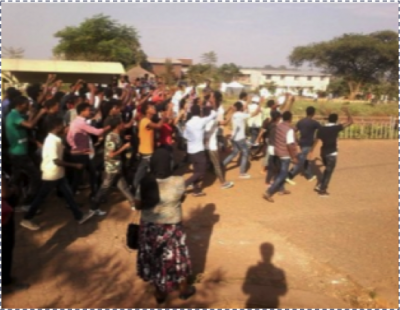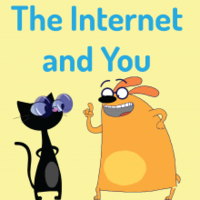Mind the risk. Once you put things out there online, it is nearly impossible to take them back.
#2 How Much Should I Share?
What It Can Look Like?

Global Voices: Global Voices is a community of writers and analysts from around the world who contribute, largely on a volunteer basis, to a news site that publishes under-reported stories on topics ranging from digital rights and activism to religion, labor, and LGBTQ rights. There is an option for authors to contribute anonymously if their safety is at stake, and the site provides specific guidelines for how to maintain anonymity when publishing online.
<embed>Related Resources
About Student Privacy
 The Youth and Media team at the Berkman Klein Center for Internet & Society at Harvard University have released curricular materials for the first through third grade level on digital privacy and safe Internet use: The Internet and You: Curricular Materials for Educators Grades 1-3. Featuring Ruff Ruffman: Humble Media Genius from PBS, The Internet and You provides interactive lesson plans and worksheets that help young learners “explore what kinds of information should be kept ‘private,’ as well as consider what kinds of situations might involve their parents or other important people in their lives.” Though this material is targeting kids younger than those of the population of the YPP Action Frame, it echoes the core issues important for self-protection. Early conditioning can do good!
The Youth and Media team at the Berkman Klein Center for Internet & Society at Harvard University have released curricular materials for the first through third grade level on digital privacy and safe Internet use: The Internet and You: Curricular Materials for Educators Grades 1-3. Featuring Ruff Ruffman: Humble Media Genius from PBS, The Internet and You provides interactive lesson plans and worksheets that help young learners “explore what kinds of information should be kept ‘private,’ as well as consider what kinds of situations might involve their parents or other important people in their lives.” Though this material is targeting kids younger than those of the population of the YPP Action Frame, it echoes the core issues important for self-protection. Early conditioning can do good!
YOUTH RADIO INTERVIEW"Protect Your Privacy"Interview and illustration by Desmond Meagley
Q. How do you help authors think through how much about themselves they should reveal? A. Many places around the world suppress free speech and sometimes simply having a dissenting view is enough to attract dangerous attention to your movement. Sahar Ghanzi, the managing editor for Global Voices' international online newsroom, illustrates why doing a simple "risks assessment" is critical when voicing support for a cause. She also outlines how she handles contributions from countries where people's voices often go unheard. Listen to the interview that follows.
|
Teachers can use the Ten Questions Content Organizer to parse a big issue into small discussion topics. Have students fill in the blanks; they can think about the choices they would make and why, and what the consequences would be like. See an example here: "Facing History with the YPP Action Framework––Focusing on Eyes on the Prize: Ain’t Scared of Your Jails”
|
Question |
Answer/Notes |
Choices |
Consequences |
|
1. Why Does It Matter to Me? |
|
||
|
2. How Much Should I Share? |
|
||
|
3. How Do I Make It About More than Myself? |
|
||
|
4. Where Do We Start? |
|||
|
5. How Can We Make It Easy and Engaging? |
|
||
|
6. How Do You Get Wisdom from Crowds? |
|||
|
7. How Do You Handle the Downside of Crowds? |
|
||
|
8. Are We Pursuing Voice or Influence or Both? |
|||
|
9. How Do We Get from Voice to Change? |
|||
|
10. How Can We Find Allies? |
Something to Consider: How Much Should We Share?
* This example is provided by the Reimagining Migration Project. The original post is found here: "Something to consider: How much should we share?"
Most educators recognize the importance of developing their students’ voice. One underappreciated aspect of helping young people find their voice is helping them become aware of the consequences of sharing particular details of their stories. For many, being heard, and listened to with respect, can be a transformational experience. This is especially true when you have been made to feel invisible. At Re-Imagining Migration, we have seen how being listened to leads to student engagement.
At the same time, we must recognize that some of our students may have complicated histories that are part of their story or their families’ story. They should be conscious of their decision to share or not to share those details. Some students may have traumatic histories that they are not quite ready to discuss or relive. Other students may not have proper authorization to be in the country or have family members without legal paperwork. Students should be very careful in thinking about whether or not to share those details out loud, among their peers; essential is the issue of how trustworthy is the context of sharing. They should be honored and provided full respect to reveal only as much as they feel they wish (and are ready) to disclose. They must not be pushed to speak out loud further than they are ready. Students should be allowed to write or draw or express themselves as they are most comfortable and not penalized by reticence (either by shaming or grading).
To recap:
- Make sure the sharing environment is safe and respectful;
- Make sure that everyone knows that they only need to share as much as they want to share;
- Make sure everyone knows that they can opt out at any point;
- Make sure that everyone knows that they can choose alternative forms of sharing such as drawing, poetry, journaling, etc.;
- Make sure that everyone knows that they do not have to make their stories public;
- Make sure there is a list of people to talk to in case issues arise including the school guidance counselor, social worker, clergy, or other trusted adults.
Harvard University Scholar Danielle Allen has been studying social change in the digital age for over eight years. Prof. Allen in her team have encountered powerful examples of storytelling. Their research led to the creation of the Ten Questions for Changemakers project. In that work, she and her team developed ten questions that they believe can help Changemakers design effective solutions to challenging social problems. One question they ask change makers to reflect upon is, “how much should I share?” The question is deceptively simple and incredibly relevant in the digital age. Online information can leave a footprint that others can follow if they seek to know more about you.
As students prepare to be interviewed by a classmate, encourage them to think, ahead of time, about the question, how much should I share?
Have students consider the advantages and disadvantages of sharing different parts of their stories publicly. We believe sharing our stories can be empowering, but we want students to be thoughtful about their own actions. Sharing some stories can put us at risk, or stir up trauma. If students haven’t thought about this question ahead of time, they can sometimes feel unprepared or put on the spot.
You can have students write their responses in a journal. Some may wish to share their thinking about this question in pairs or small groups, whereas, in other classrooms, teachers may want to keep this as a solo activity.
This page is part of our Moving Stories educators guide, use this link to learn more.
*Note: We have anticipated this dilemma in the design of the Moving Stories app. The settings allow users to upload or not upload the interview, and includes a variety of sharing settings. There are is also a feature that allows educators to create password protected story-sharing areas on the Moving Stories website.
- Better Not to Say
- “Public vs. Private” (a video clip)
- The Voice section in Digital Civics Toolkit
- What do I choose to share publicly and what do I keep to myself?
- DIY Toolkit: Controlling your online presence
- How do I manage the ‘digital afterlife’ of my voice?
- Singapore's Cyber Wellness Curriculum
- Youth and Articifial Intelligence: Where We Stand
Related News Articles
- "WhatsApp Suggests a Cure for Virality." The Economist 28 Jul. 2018.
- Danielle Allen, “Ten Questions for the Parkland Kids.” Washington Post 7 Mar. 2018.



